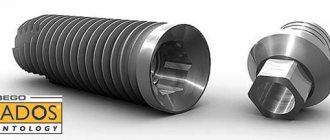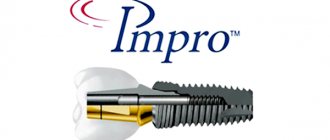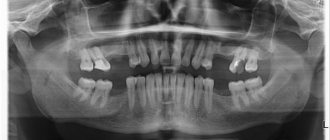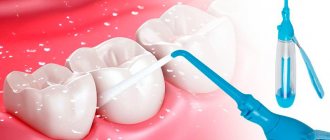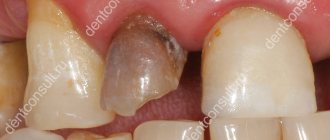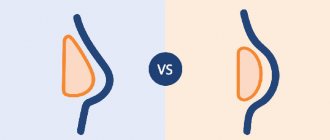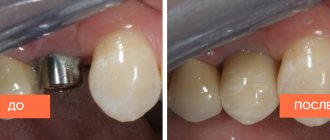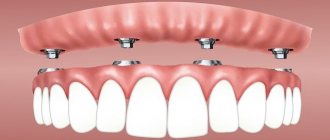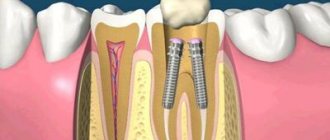What is better - a pin or an implant? This is the question asked by people who decide to restore lost teeth. To make a decision, you need to know the difference between these orthopedic structures. In some cases, a successful solution to restoring the dentition will be to implant a pin into the root of the tooth. In case of complete root removal, the replacement option is an artificial implant. Let's look at all the details in detail.
Differences between an implant and a post
First, let's understand the concepts:
- An implant is a rod (usually titanium) that is inserted (screwed) into the jawbone. Essentially, an implant (or implant) is an artificial tooth root. An abutment is then installed on it, and then a crown.
3d model of a dental implant
- A pin is a thin (compared to an implant) rod that is installed into the root of the tooth. These products are used to preserve natural roots and strengthen the crown part of the tooth (provided that it is preserved by at least 50%)1.
3d model of a dental pin
If implants are used when a tooth with a root is no longer there, then pins are used to save teeth that have not yet been lost (but need strengthening). The main condition for installing a pin is intact root canals.
The main differences between an implant and a pin are given in Table 1.
Table 1. Characteristics of pins and implants
| Parameter | Implant | Pin |
| Installation method | Implanted into the bone, imitating tooth roots | Placed in the root of the tooth |
| Purpose of the product | Tooth root replacement | Strengthening and preserving natural teeth |
| How long does it last | Several decades | The pin slows down tooth decay. Service life depends on the condition of the tooth |
| Additional treatment | Sometimes bone grafting is needed (if there is not enough bone tissue in the jaw) | It is necessary to remove the dental nerve and fill the canals |
| Treatment period | 2-5 months | Up to 1 month |
| Price | High | 3-7 times cheaper than implants |
Manufacturing companies
Which manufacturing companies offer the best products? All prostheses can be divided into three categories depending on the price range:
- premium;
- mid-price;
- low priced.
What is the difference between these types? The difference between these implants is durability and wear resistance. The higher the price, the stronger the structure. The high-price segment includes products from the following companies:
- Nobel Biocare;
- Straumann;
- Astra Tech.
Nobel Biocare products are characterized by a high degree of integration of the material into bone tissue. The rejection rate is almost zero. The approximate price for one tooth ranges from 40,000 to 70,000 rubles.
The Swiss company Straumann gives an unlimited warranty on its products. The price for one implant is about 45,000 rubles. The Swedish company Astra Tech estimates its products at around 35,000 per implant.
The average price category of prostheses is less durable in use. Products in this category are represented by the following companies:
- Dentsply Friadent;
- Zimmer;
- Schlutz Dental;
- Rusimplant;
- MIS.
A distinctive feature of Dentsply Friadent products is the invisibility of the transition boundary between the crown and the rod. The price for one prosthesis is 35,000 rubles. The cost of products from the American company Zimmer ranges from 18,000 to 30,000 rubles. The price depends on the size of the implant.
The German company Schlutz Dental produces a variety of products at prices ranging from 20,000 to 30,000 rubles per implant. In the same price range are products from the Russian company Rusimplant and the Israeli company MIS.
In the low price range (7,000 - 17,000 rubles) there are products from Ukrainian, Belarusian and Russian manufacturers.
Pin or implant: advantages and disadvantages
It is incorrect to talk about the advantages of one product over another, since pins and implants have different purposes. Therefore, we will talk about the pros and cons of pins and implants separately.
Pros of implants:
- complete tooth restoration;
- long service life (up to lifelong);
- artificial teeth look good (practically no different from natural teeth);
- there are no dietary restrictions (implants can withstand the load when consuming all types of food);
- low probability of rejection (less than 1% of cases).
Cons of implants:
- the need for surgical intervention;
- standard risks associated with surgery (for example, infection);
- long period of treatment (up to 2-5 months);
- high cost of dental implantation.
The main advantage of the pin is that it allows you to preserve the existing natural tooth for a long time. But there are other advantages of these products.
Advantages of pins:
- the product is easily placed at the root;
- relatively low cost of the pin;
- high aesthetic indicators;
- the ability to attach a fixed or removable prosthesis.
Disadvantages of pins:
- relatively short service life (most often it is 2-3 years - the time for which it is possible to save a decaying tooth);
- instability to significant loads on the chewing teeth (if the load is uneven, the root walls can be damaged);
- wedging effect (pins expand the boundaries of the tooth, which can damage surrounding tissues)2;
- there is a danger of developing allergic reactions;
- the likelihood of developing secondary caries increases;
- Metal pins can only be removed together with the tooth.
Material of manufacture
A variety of materials can be used, including:
- Metals and composites are the most popular option, they are easy to manufacture, durable and have an affordable price;
- Ceramic - similar to natural tooth enamel, the most aesthetic option;
- Zirconium - combines the best qualities of the previous options - they are aesthetically pleasing and durable, but are not very popular because they are very expensive.
Complications after installation
After installing the pin, the patient may experience discomfort for the first 1-2 days. If this feeling does not go away after 2 days, then it is recommended to consult a dentist or your doctor.
When installing some types of pins, a fracture of the tooth root is possible. But such consequences are extremely rare. If you follow all the doctor’s recommendations, there are almost no complications after installing the pin.
As for dental implantation, after such an operation patients are often concerned about temporary complications. These are bleeding gums, pain, swelling, sensation of a foreign body in the mouth. However, this condition goes away in a few days. If pain after implantation lasts longer than 8-10 days, consult a doctor.
It is extremely rare (less than 1% of cases) to experience implant rejection. This process occurs in the first months after installation. It is impossible not to notice him. It is accompanied by severe pain and bleeding. Contact your doctor immediately!
Stage 1: diagnosis
It may take some time to choose a clinic and an implantologist, since this is one of the key points in the whole story. In addition, you need to get to know the orthopedist and, if necessary, the therapist - these doctors will also take part in the process of implantological treatment. If everything is satisfactory, then before implantation an examination is carried out by a surgeon.
He will tell you whether it is possible in principle to place an implant in this patient, and will develop further treatment tactics based on the following data:
- general oral health;
- the presence and condition of neighboring teeth and gums, which are located next to the future implant root;
- bite;
- hygiene quality;
- financial capabilities of the patient.
The price is usually included in the total cost of treatment, which is carried out in most clinics on a turnkey basis. The doctor will announce the approximate cost, the final price is determined after diagnostic testing and consultation with an orthopedist. If a patient needs the help of a physician, hygienist or periodontist, then their services should be considered.
Diagnostics includes instrumental and laboratory studies, without which surgery is impossible. These examinations are necessary to exclude a number of complications after the introduction of implant rods and achieve extremely good treatment results.
Aesthetics: what looks more natural - an implant or a pin?
With implantation, the tooth is completely restored. The crown is selected so that it does not differ from other teeth. In this sense, aesthetic requirements during implantation are better satisfied, since all the work is done from scratch. This is especially true for the front teeth.
Installation of a dental implant
As for the pins, in this case it is possible to achieve good aesthetics. But here you need to take into account what work will be done after installing the pin. There may be several scenarios:
- extension of the crown part of the tooth;
- tooth reinforcement;
- splinting teeth in the treatment of periodontal diseases;
- prosthetics with pins.
In this regard, aesthetic characteristics are highly dependent on the current condition of the tooth. But in general, the external characteristics of dental implantation are better than those of installing a pin (if we also take into account the fact of the comparative fragility of pin structures).
Installation of a dental post
What is the price difference
Having different dental tasks and methods of application, the installation of a pin and the implantation of an implant differ significantly in price . It is quite natural that an implant, which is a full-fledged prosthesis, is more expensive than a pin, which serves as a reinforcement of natural material.
Implantation is more durable and aesthetically pleasing, which affects its price.
| Service | Cost, rub. |
| Implantation without implant cost | 10000-20000 |
| Pin installation | 2000-5000 |
The cost of implantation in Moscow depends on the region and the prestige of the clinic. The cost of installing a pin is also affected by the material from which it is made.
Contraindications for installation
Both implants and pins have a list of contraindications.
Contraindications for installing pins:
- damage and/or splitting of the tooth root;
- inflammatory periodontal diseases;
- cysts or granulomas in the area of the tooth root;
- tooth with pulp (the pulp must be removed before installation);
- if the thickness of the root canals is less than 2 mm (the canals are first expanded).
Contraindications to implantation:
- blood diseases;
- malignant tumors;
- severe forms of immunodeficiency;
- hypersensitivity to titanium;
- allergy to anesthetics used during implantation;
- severe neurological and mental illnesses;
- pregnancy and lactation.
There are also temporary contraindications for pins and implants. For example, these are inflammatory diseases or poor oral hygiene. For these purposes, treatment is initially carried out to eliminate all these disorders.
Clasp prosthetics or dental implantation
Clasp prosthesis refers to a removable type of orthopedic structures. The design consists of a metal frame (archwire, clasp) with acrylic gum and artificial crowns. They are used for the restoration of extended dental defects. A modern representative of clasp (arch) structures is the Quattro Ti denture.
The availability of installation of an orthopedic structure is determined by the presence of supporting teeth to which it is attached. In case of terminal defects or complete edentia, such products are not used.
Available mounting types:
- Clasps are hooks made of metal or plastic that cover a support.
- Attachments are a locking or hinge device consisting of two elements that are inserted into each other to securely fix the prosthesis. One part of the lock is attached to the supporting unit, the second is located on the prosthetic structure.
- Telescopic crowns are double crowns used for anchoring the clasp system. It has two parts - one (inner) is attached to the support with cement, the second (outer) is connected to the prosthesis, acting as a fixing element of the latter.
Advantages:
- Securely fixed in the oral cavity;
- strong, durable;
- easy care and maintenance;
- do not injure the mucous membrane;
- can be used for mobility of abutment teeth;
- do not create discomfort when wearing;
- are created from biocompatible materials.
Flaws:
- Long-term addiction (2-4 weeks or more);
- possible allergy to the metal frame;
- the entire chewing load falls on the supporting teeth and gums;
- clasps are noticeable at close range;
- installation of a prosthesis on attachments or telescopic crowns is possible only after depulpation and turning of the supports;
- regular relocation and replacement of structures;
- does not prevent bone atrophy;
- It is not always possible to repair a denture.
Clasp constructions are considered a reliable method of dental prosthetics, but still have disadvantages. A reasonable solution would be to replace teeth with a non-removable structure on implants. Implant-supported prosthetics do not have the disadvantages that the clasp system demonstrates. Focusing on functionality and aesthetics, dental implantation wins in both options.
FAQ
What to choose - a pin or an implant?
This is decided by the doctor. There are indications for installing pins, and there are indications for implantation or prosthetics. If the tooth can still be saved by strengthening it, then it is often suggested to install a pin. If the doctor sees that the pin only saves the situation for a short time, then he can immediately offer the patient the option of implantation, so as not to waste any extra money or time.
Is it possible to install a pin in a dead tooth?
The pin is installed after depulpation - removal of the vascular bundle with nerves (pulp). If this is not done, the pin will constantly irritate the nerve endings, which results in pain. Therefore, the pin is installed only on a dead (i.e., pulpless) tooth.
What is more expensive - a pin or an implant?
An implant is 3-7 times more expensive. The price factor is one of the most important when deciding to install a dental post or implant. At the same time, the patient needs to understand that the pins are short-lived, and in a few years (at best) he will again have to face the problem of tooth restoration. Therefore, in the future, placing implants may be cheaper than other types of restoration and restoration of the dentition.
Which is more painful to install?
The procedure is performed under anesthesia, so the patient will not feel anything. Since installing implants is a more invasive method (since incisions are required in the jawbone), the postoperative period may be accompanied by pain. Painkillers are used for this.
ATTENTION!
This material is not a substitute for medical advice and should not be used for diagnosis or treatment.
Sources:
- Aurélio IL, Fraga S, Rippe MP, Valandro LF. Are posts necessary for the restoration of root filled teeth with limited tissue loss? A structured review of laboratory and clinical studies. Int Endod J. 2016 Sep;49(9):827-835. doi: 10.1111/iej.12538. Epub 2015 Sep 19. PMID: 26331486.
- Goracci C, Ferrari M. Current perspectives on post systems: a literature review. Aust Dent J 2011 Jun;56 Suppl 1:77-83. doi: 10.1111/j.1834-7819.2010.01298.x. PMID: 21564118.
But what do braces have to do with it?
An important feature of implants is that when chewing they experience stress, and it is transferred to the internal part (pin). Therefore, it is very important to correctly calculate the location of the implant and its angle of inclination. The crown that will be installed on the implant after healing must be in the correct position relative to the remaining teeth so that there is no increased load when closing. Otherwise, the implant will not last long.
Each implant has its own installation angle, which is calculated individually
Preparation for implantation includes modeling the process in a special program. This is a very important stage on which the success of treatment depends. And it is at this stage that a problem may arise: if the bite is incorrect, implants most often cannot be installed, since it simply will not be possible to do it correctly.
Implantation is a complex and expensive procedure. In good clinics, doctors give a guarantee for the work performed, and this, as a rule, is not 1 year, but much longer. Therefore, an experienced doctor will not undertake treatment for a malocclusion, since he will not be able to guarantee a good result.
Sometimes bite problems are not visible to the person himself; for example, with a direct or deep bite, the teeth can be straight and the smile looks generally attractive. But still, this creates a problem for implantation.
Example: teeth are straight, but the occlusion is incorrect
And although treatment by an orthodontist will seriously delay the day when prosthetics can be performed (by at least several months), this stage cannot be skipped.
How to quickly and easily carry out treatment before implantation
Those who have not previously thought about treatment with an orthodontist are not motivated to wear braces, and this is understandable. But now, thanks to aligners, it is possible to undergo treatment in a short time. In addition, such an orthodontic system is invisible to others. Aligners are superior to braces in most important parameters and are best suited for preparation for implantation, since treatment with them is quick.
Preparation for implantation can take from several months to a year, depending on the initial situation. But such comprehensive treatment will bring benefits in the future, since with a correct bite it is easier to maintain healthy teeth.
It is better to correct the bite as early as possible. But if this does not work out, then you can contact an orthodontist at any age, even at 45–50 years old and later (nowadays older patients are not uncommon).

